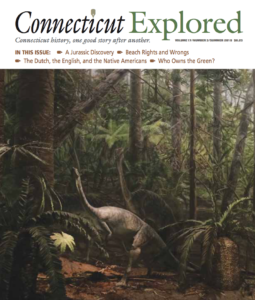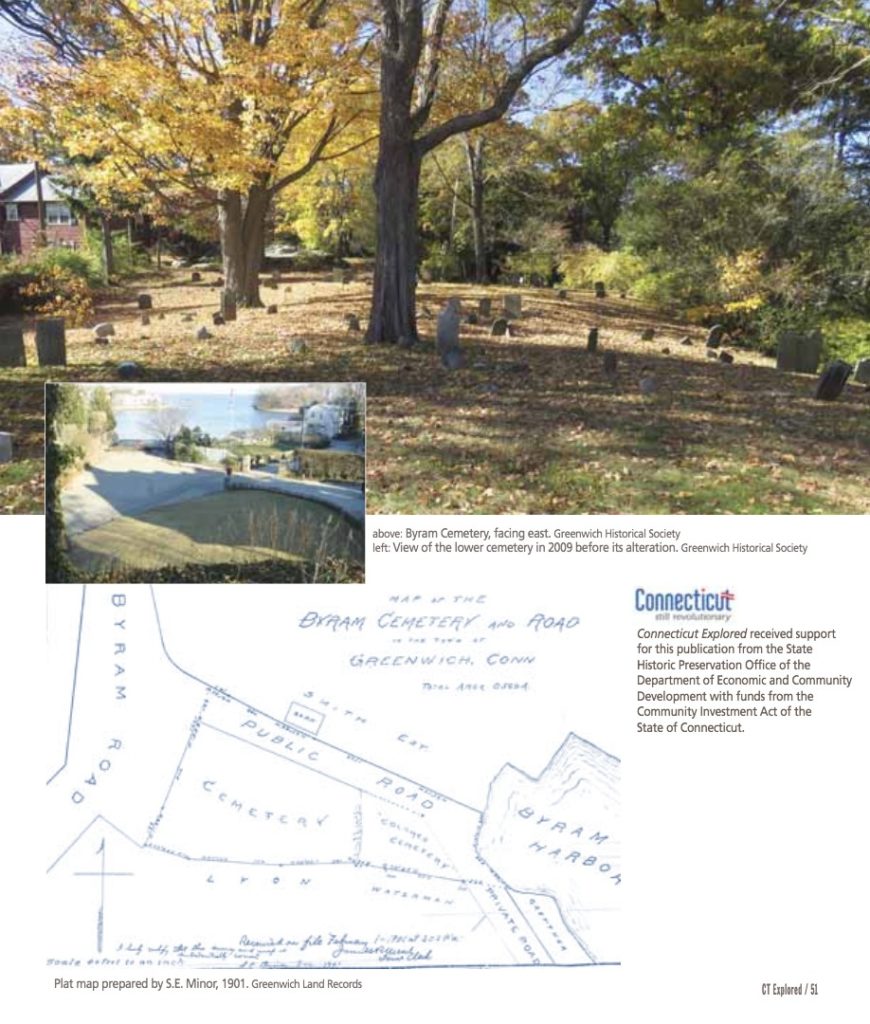(c) Connecticut Explored Inc. Summer 2019
Subscribe/Buy the Issue!
In states across the country, cemeteries, due to their inherently different nature, are not subject to the laws of ordinary property. A recent property dispute in Greenwich—one resolved in a way that protected the remains of historically marginalized populations—highlights the value of Connecticut’s abandoned cemeteries law. Among Connecticut’s 80 statutes relating to cemeteries is Connecticut General Statute §19a-308a, which allows municipalities to acquire legal title to abandoned cemeteries. This statute, effective in July 2009, defines an abandoned cemetery as one:
(1) in which no burial has occurred during the previous forty years and in which the lots or graves have not been maintained during the previous ten years except for maintenance rendered by the municipality in which such cemetery is located, (2) in which one burial has occurred in the past forty years, for which a permit was issued under section 7-65 after such burial, or (3) in which no lots have been sold in the previous forty years and in which most lots and graves have not been maintained during the previous ten years except for maintenance rendered by the municipality in which such cemetery is located.
The remainder of the statute describes the process of acquisition and future care of the site. The law does not differentiate between public and private cemeteries, nor should this definition of “abandoned cemeteries” be thought to apply to cemeteries that are simply neglected.
It can be difficult for municipalities to find legal guidance on cemeteries. No state agency or person is responsible for the oversight of cemeteries, and there is no comprehensive inventory of cemeteries in the state. A survey conducted by Charles R. Hale in the 1930s documented more than 2,000 cemeteries considered historic at that time. Many are still visible and well maintained, while others are barely discernible from their surrounding landscape. And Hale missed some.
A complicated but informative example of an abandoned cemetery emerged in Greenwich in 2014. The Town of Greenwich had approved a request to improve vehicle access to a residence off Byram Dock Street that included removal of a natural rock formation. The project encroached on a historic cemetery frequently depicted on historic maps. The cemetery’s three sections were referred to by various names but are generally known as the Byram Cemetery and Lyon Family Plot, on the upper terrace, and the “Colored Cemetery.” The latter, located at a lower elevation and separated by a rock ledge, likely was used to inter people of indigenous and African descent. While the upper Byram-Lyon Cemetery has the characteristic headstones, footstones, and enclosures frequently associated with historic Euro-American cemeteries, the “Colored Cemetery” lacked any recognizable indicators. The absence of stone monuments may reflect cultural traditions, marginalized social status, unpreserved memorials, or some combination of these factors.
 Despite its documentation on maps and consistent with many of Connecticut’s early cemeteries, no evidence of a deed, indicating fee simple ownership, was found for the land used for interment. The cemetery does, however, appear as a boundary marker in a deed from 1752 and again in more than a dozen subsequent land transactions for surrounding properties. Its boundaries appear stable through time, and the property is referred to interchangeably in these legal documents as a burying place, a burying ground, anda graveyard.
Despite its documentation on maps and consistent with many of Connecticut’s early cemeteries, no evidence of a deed, indicating fee simple ownership, was found for the land used for interment. The cemetery does, however, appear as a boundary marker in a deed from 1752 and again in more than a dozen subsequent land transactions for surrounding properties. Its boundaries appear stable through time, and the property is referred to interchangeably in these legal documents as a burying place, a burying ground, anda graveyard.
When the neighboring homeowners began their renovation project, construction equipment was being stored on the unmarked burial ground, rock ledge had been cut back, and terracing of the land was under way. The town issued a cease and desist order because the homeowners did not have permission to transform a parcel they did not own. In May 2016 the board of selectmen approved acquiring all three cemetery parcels under the state’s abandoned cemetery law. In response, the homeowners sued to block the town from acquiring legal title to all three cemeteries, arguing that there was no proof that anyone had been buried in the parcel depicted on maps as the “Colored Cemetery,” and requested they be given ownership of this lower parcel.
The case proceeded in Stamford’s Superior Court. An important decision in the case was the granting of legal standing to six descendants of African American and Native American people presumed to have been buried in the lower cemetery, as the Greenwich Time reported August 6, 2018. After more than a year of litigation, the parties came to an agreement at the end of 2018. The settlement includes adding a stonewall to enclose the lower cemetery, adding a commemorative plaque, allowing the homeowners to retain use of the rear driveway, and the granting of ownership of all three cemeteries to the Town of Greenwich.
Catherine Labadia is Deputy State Historic Preservation Officer, Environmental Reviewer, and Staff Archeologist.
 Connecticut Explored received support for this publication from the State Historic Preservation Office of the Department of Economic and Community Development with funds from the Community Investment Act of the State of Connecticut.
Connecticut Explored received support for this publication from the State Historic Preservation Office of the Department of Economic and Community Development with funds from the Community Investment Act of the State of Connecticut.

